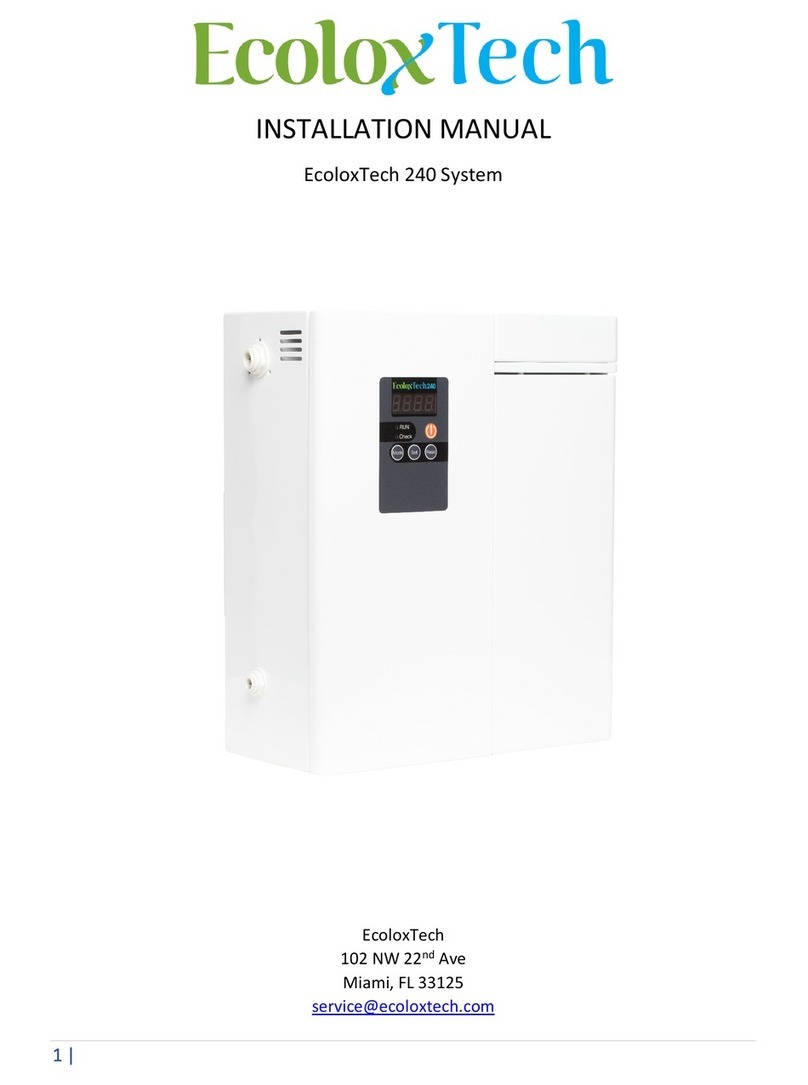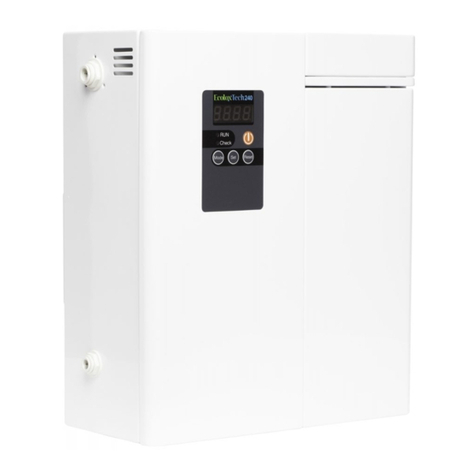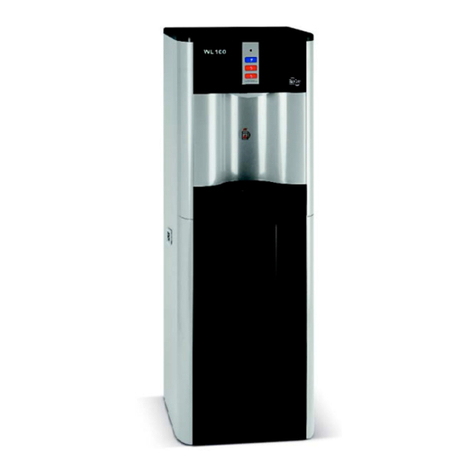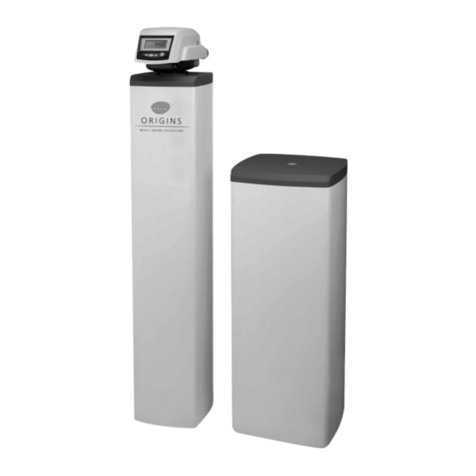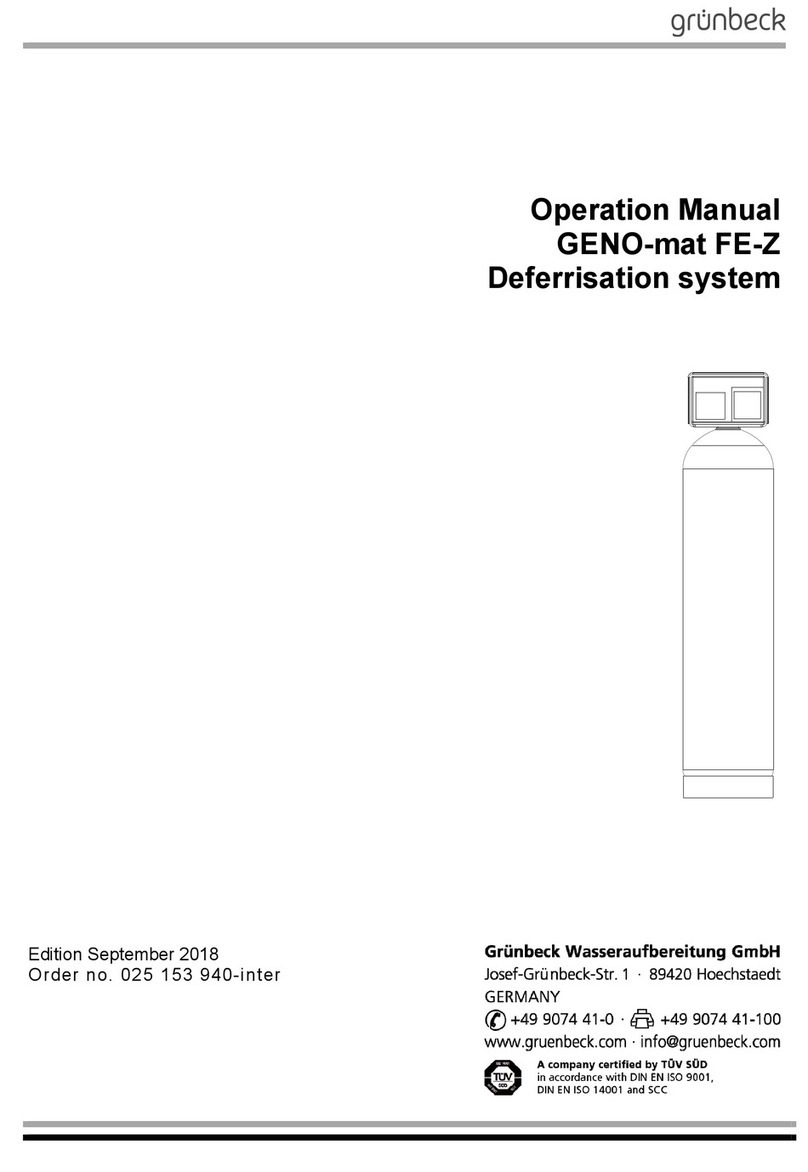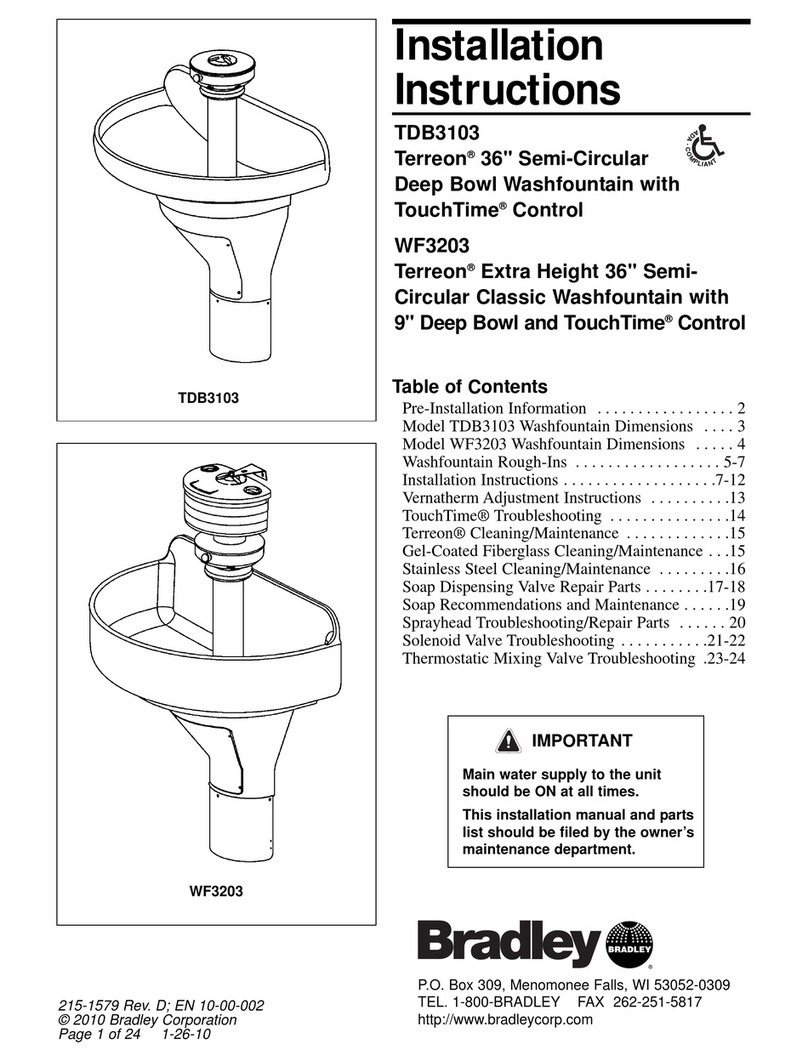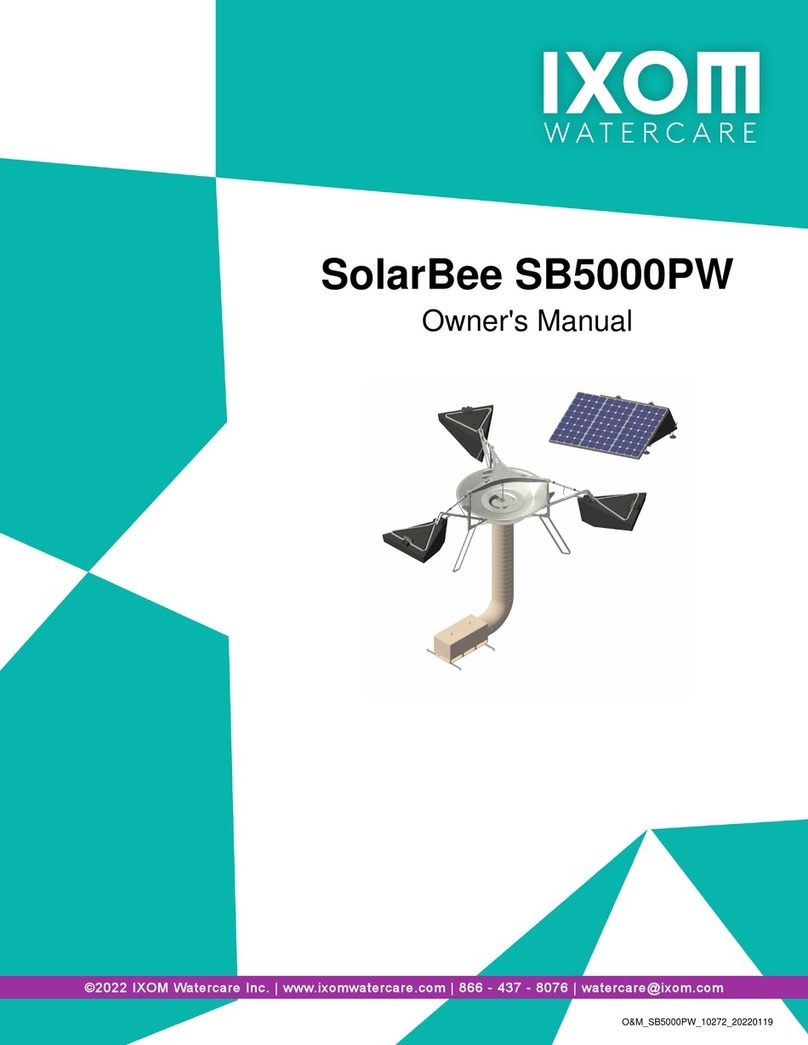EcoloxTech E-240 System User manual

2
Table of Contents
Specifications Page 3
Requirements Page 3
Buttons and Display Page 4
Operational Modes Page 4
Settings & Performance Page 5
System Alarms Page 5
Safety Precautions Page 6
Additive Formulas Page 6
Changing Additive Page 7
Controlling Concentration Page 7
Measuring Concentration Page 9
Routine Maintenance Page 9

3
Model E-240
Power AC 110/220V 50/60HZ 180W
Dimensions 32 x 17 x 42 cm (12.5 x 6.5 x 16.5 in)
Weight 11.8 kg (26 lbs.)
Production Cell Type Single cell electrolysis for generating hypochlorous acid (HOCl)
Concentration Range 20 to 150 ppm of free available chlorine (FAC)
Ampere Settings 13 to 22 amp
Pump Speed Settings 0 to 19 (max. speed to min. speed)
Ambient Temperature 5 to 50 °C (41 to 122 °F)
Feed Water & Brine Temperature 10 to 30 °C (50 to 86 °F)
Feed Water & Brine Water
Quality Hardness < 80 ppm (higher will damage the electrolysis cells)
Humidity Less than 96% Relative Humidity (RH)
Minimum Flow Rate 3 L/min
Maximum Water Pressure 40 PSI
Specifications
Requirements

4
Buttons and Display
No Description
1LED display
2System is running
3Check error code in LED display
4System RUN On/O
5Mode button (see uses below)
6Set button (see uses below)
7Reset alarm to resume running
Standard Mode The standard mode is the default and should be used unless connecting system to a
holding tank with a float sensor.
Setting to standard mode:
1. Press and hold “Set” button for 3 seconds and release
2. Press “Reset” button once
3. Press and hold “Mode” button for 3 seconds and release
Level Mode This mode must be used when connecting the system to a holding tank using a float
sensor. The system will automatically stop running when the water level rises to the
level to activate the float sensor.
Setting to level mode:
1. Press and hold “Set” button for 3 seconds and release
2. Press “Set” button once
3. Press and hold “Mode” button for 3 seconds and release
Operational Modes

5
Flow Rate measured in
Liters per minute (L)
The flow rate can be controlled by tightening or loosening the inflow water valve. A
higher flow rate will decrease the concentration of free available chlorine (FAC) and a
lower flow rate will increase the concentration of FAC.
Displaying the flow rate:
1. Press and hold “Set” button for 3 seconds and release. LED display will begin to blink.
2. Press “Mode” button until liters per minute (L) setting is displayed.
Voltage (v)
The voltage is a performance measurement and is not adjustable.
Displaying the voltage:
1. Press and hold “Set” button for 3 seconds and release. LED display will begin to blink.
2. Press “Mode” button until voltage (v) setting is displayed.
Ampere (A)
Max. ampere: 22
Min. ampere: 13
The ampere is an adjustable setting. The range is from 13 to 22 ampere. Higher settings
will increase the concentration of free available chlorine (FAC).
Adjusting the ampere:
1. Press and hold “Set” button for 3 seconds and release. LED display will begin to blink.
2. Press “Mode” button until ampere (A) setting is displayed.
3. Press “Set” button to increase the ampere. Press “Reset” button to decrease the
ampere.
4. Press and hold “Mode” button for 3 seconds and release to complete.
Pump Speed (PS)
Max. speed: 0
Min. speed: 19
The pump speed is an adjustable setting. The range is from 0 to 19. Lower settings will
increase the pump speed and thus increase the additive dosed into the electrolysis cell.
For most purposes, the pump speed should be kept in mid-range.
Adjusting the pump speed:
1. Press and hold “Set” button for 3 seconds and release. LED display will begin to blink.
2. Press “Mode” button until pump speed (PS) setting is displayed.
3. Press “Set” button to increase the pump speed. Press “Reset” button to decrease
the pump speed.
4. Press and hold “Mode” button for 3 seconds and release to complete.
Settings & Performance
Error Code Reason Action
Err1 Low Flow
Check the flow of the feed water into the equipment. Once corrective action has been taken
to sustain the water flow above 3 L/min, press the “Reset” button to cancel the alarm. If
unresolved, contact the service center.
Err2 Low Current Disconnect additive tank and refill with a new brine. Re-attach the tank once completely
dissolved. Press the “Reset” button to cancel the alarm. If unresolved, contact the service center.
Err3 High Current Disconnect additive tank and refill with a new brine. Re-attach the tank once completely
dissolved. Press the “Reset” button to cancel the alarm. If unresolved, contact the service center.
Err4 Low Voltage The voltage is abnormally low. Please contact the service center for further assistance.
Err5 Fan Error The cooling fan is not functioning. Please contact the service center for further assistance.
System Alarms

6
Safety Precautions Brine / Additive Formulas
Ventilation Risks
Electrolyzed water contains small quantities of hydrogen gas (H2), chlorine dioxide gas
(ClO2), and ozone gas (O3) that is released from solution into the air. These gases, if
accumulated, can be explosive. Electrolyzed water contains free chlorine molecules.
Free chlorine molecules have the potential to form chlorine gas (Cl2) when the pH of
the solution becomes acidic. Chlorine gas, if inhaled, can cause respiratory irritation
or injury and is a health risk. Equipment must be installed in a ventilated area to avoid
the accumulation of gases. Do not install equipment near heat sources over 400°C
(750°F)
Electric Shock and Fire Risks
Only use certified outlets. Do not place the equipment in water or allow the equipment
to be exposed to external sources of water. Do not operate equipment if electric cord
is damaged. Do not operate equipment in environments of relative humidity greater
than 95%. In the event of an electric shock or fire, equipment must be removed from
the power source immediately.
Formula # HOCl Solution Formula Instructions
1
Using Formula #1 the system will
generate a free chlorine solution
in which over 25% of the chlorine
molecules will be hypochlorous acid
(HOCl).
pH ≈7-8
**GOOD**
Formulation
• 28% Food Grade Salt (NaCl).
• 72% Water (tap water, reverse osmosis or distilled)
When preparing 2-Liter additive tank:
1. Add 550 g (≈2 cups) of salt*
2. Fill remainder with water (1400 mL)
3. Shake until salt fully dissolved
* No iodine or other additives (ie. kosher salt)
2
Using Formula #2 the system will
generate a free chlorine solution
in which over 70% of the chlorine
molecules will be hypochlorous acid
(HOCl).
pH ≈6-7
**BETTER**
Formulation
• 28% Food Grade Salt (NaCl).
• 72% Food Grade 5% White Distilled Vinegar
When preparing 2-Liter additive tank:
1. Add 550 g (≈2 cups) of salt*
2. Fill remainder with 5% distilled vinegar (1400 mL)
3. Shake until salt fully dissolved
* No iodine or other additives (ie. kosher salt)
3
Using Formula #3 the system will
generate a free chlorine solution
in which over 90% of the chlorine
molecules will be hypochlorous acid
(HOCl).
pH ≈5-6
**BEST**
ATTENTION: Proper personal protective gear required when
preparing additive with hydrochloric acid (HCl).
Formulation
• 72% Water (tap water, reverse osmosis or distilled)
• 19% food grade salt (NaCl).
• 9% hydrochloric acid (HCl).
When preparing 2-Liter additive tank:
1. Add 380 g of salt*
2. Add 1440 mL of water
3. Shake until salt fully dissolved
4. Add 180 mL of hydrochloric acid (HCl)**
* No iodine or other additives (ie. kosher salt)
**Use technical grade HCl (32%) for general sanitation. For food
contact, must use FCC grade HCl (35-37%).

7
Changing Additive
Controlling Concentration
Using Additive Formula 1 (Water and Food Grade Salt)
Using Additive Formula 1 (Water and Food Grade Salt)
Replenish additive tank when low. If additive runs out, the system will
stop and display Error 2.
Changing Additive Using Formula #1
•Power Off system
•Remove suction line and cap from additive tank
•Add 2 cups of salt to additive tank
•Fill remainder of additive tank with tap water
•Replace cap and shake until dissolved
•Replace suction line
•Power On system and press “Reset” button
The following settings are recommendations for reaching approximate concentrations of free available chlorine (FAC)
in solution measured in parts per million (ppm). The 3 variables below can be adjusted to change the concentration.
1. Flow Rate (L/min) – controlled by blue valve allowing feed water to flow into system
2. Ampere (A) - controlled by system settings
3. Pump Speed (PS) - controlled by system settings
17.5 A 22.0 A
0 PS 85 ppm 100 ppm
2 PS 82 ppm 96 ppm
4 PS 79 ppm 92 ppm
6 PS 76 ppm 88 ppm
8 PS 73 ppm 86 ppm
10 PS 70 ppm 82 ppm
17.5 A 22.0 A
0 PS 64 ppm 80 ppm
2 PS 62 ppm 77 ppm
4 PS 60 ppm 74 ppm
6 PS 58 ppm 71 ppm
8 PS 56 ppm 68 ppm
10 PS 54 ppm 65 ppm
Flow Rate 3.0 L/min
Flow Rate 4.0 L/min

8
Using Additive Formula 2 (Distilled White Vinegar and Food Grade Salt)
17.5 A 22.0 A
0 PS 75 ppm 90 ppm
2 PS 72 ppm 86 ppm
4 PS 69 ppm 82 ppm
6 PS 66 ppm 78 ppm
8 PS 63 ppm 76 ppm
10 PS 60 ppm 72 ppm
Flow Rate 3.0 L/min
Using Additive Formula 1 (Water and Food Grade Salt)
17.5 A 22.0 A
0 PS 60 ppm 75 ppm
2 PS 57 ppm 71 ppm
4 PS 54 ppm 67 ppm
6 PS 51 ppm 63 ppm
8 PS 48 ppm 59 ppm
10 PS 45 ppm 55 ppm
Flow Rate 5.0 L/min
Using Additive Formula 2 (Distilled White Vinegar and Food Grade Salt)
Using Additive Formula 2 (Distilled White Vinegar and Food Grade Salt)
17.5 A 22.0 A
0 PS 54 ppm 70 ppm
2 PS 52 ppm 67 ppm
4 PS 50 ppm 64 ppm
6 PS 48 ppm 61 ppm
8 PS 46 ppm 58 ppm
10 PS 44 ppm 55 ppm
17.5 A 22.0 A
0 PS 50 ppm 65 ppm
2 PS 47 ppm 61 ppm
4 PS 44 ppm 57 ppm
6 PS 41 ppm 53 ppm
8 PS 38 ppm 49 ppm
10 PS 35 ppm 45 ppm
Flow Rate 4.0 L/min
Flow Rate 5.0 L/min

9
Using Additive Formula 3 (Water, Food Grade Salt, and HCl)
Using Additive Formula 3 (Water, Food Grade Salt, and HCl)
Using Additive Formula 3 (Water, Food Grade Salt, and HCl)
17.5 A 22.0 A
0 PS 115 ppm 150 ppm
2 PS 110 ppm 144 ppm
4 PS 105 ppm 138 ppm
6 PS 100 ppm 132 ppm
8 PS 95 ppm 126 ppm
10 PS 90 ppm 120 ppm
17.5 A 22.0 A
0 PS 74 ppm 95 ppm
2 PS 70 ppm 90 ppm
4 PS 66 ppm 85 ppm
6 PS 62 ppm 80 ppm
8 PS 58 ppm 75 ppm
10 PS 54 ppm 70 ppm
17.5 A 22.0 A
0 PS 66 ppm 85 ppm
2 PS 62 ppm 80 ppm
4 PS 58 ppm 75 ppm
6 PS 54 ppm 70 ppm
8 PS 50 ppm 65 ppm
10 PS 46 ppm 60 ppm
Flow Rate 3.0 L/min
Flow Rate 4.0 L/min
Flow Rate 5.0 L/min

10
Measuring Concentration
The concentration of free available chlorine (FAC) can be measured with standard chlorine test paper. The range and
sensitivity measurable are 10, 50, 100, and 200 ppm.
For greater accuracy or to measure high range free available chlorine levels, the chlorine concentration can be
mesre ith hih re chlorie hotometer.
lies or mesri ree chlorie cocetrtio c e o t and search SKU listed below.
Chlorine Test Paper (SKU: P-1050)
Chlorine Photometer (SKU: P-1047)
Maintenance
Over time and depending on use, mineral scale can build-up on the electrolysis cells. Mineral scale build-up depends on
the quality of the inflow water. If the hardness of the inflow water is less than 80 ppm, scale will build up very slowly and
the system may not require maintenance for many years. Using the incorrect salt can cause mineral scale to build up very
quickly. If mineral scale does build up, the electrical current required to generate a free chlorine solution of hypochlorous
acid will be disrupted.
When to do Maintenance:
When the actual ampere of the system drops to a level below 90% of the set ampere, the systems electrolysis cells should
be descaled of mineral deposits.
How to do Maintenance:
Simply run the system using additive formula #3 with hydrochloric acid (HCl). The HCl will descale the mineral deposits
from the electrolysis cells. Run the system until the actual ampere returns to the set ampere. This could take 30 minutes or
several hours depending on the amount of scale.
This manual suits for next models
1
Table of contents
Other EcoloxTech Water System manuals
Popular Water System manuals by other brands
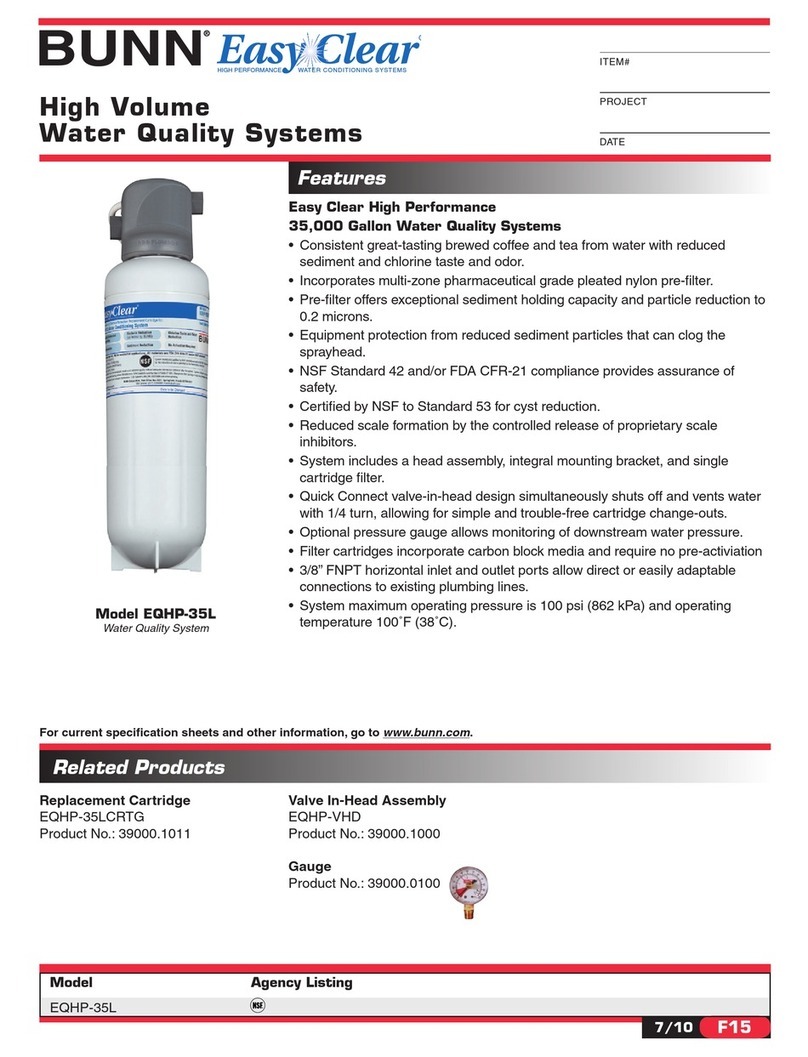
Bunn
Bunn Water Quality System EQHP-35L Specification sheet
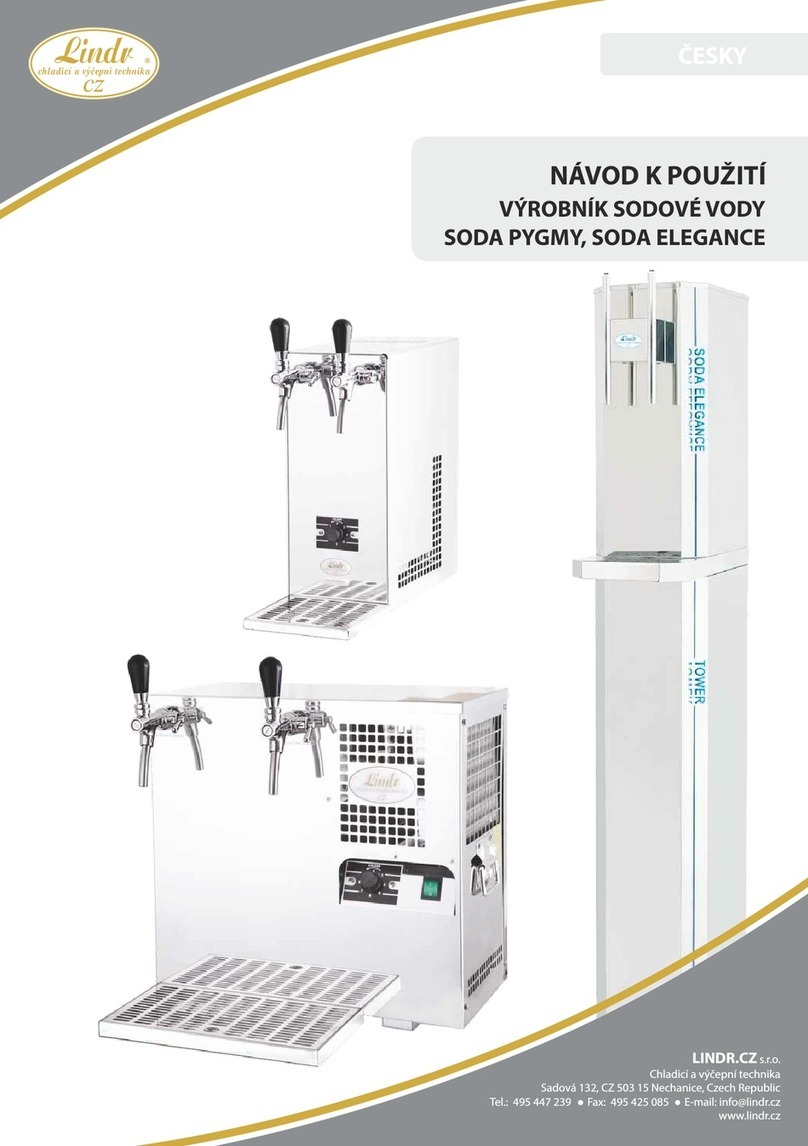
LINDR
LINDR SODA PYGMY Instructions for use

Zip
Zip HydroTap G4 BCS160/175 Installation and operating instructions

kinetic
kinetic Arsenic Guard Homeowner's information
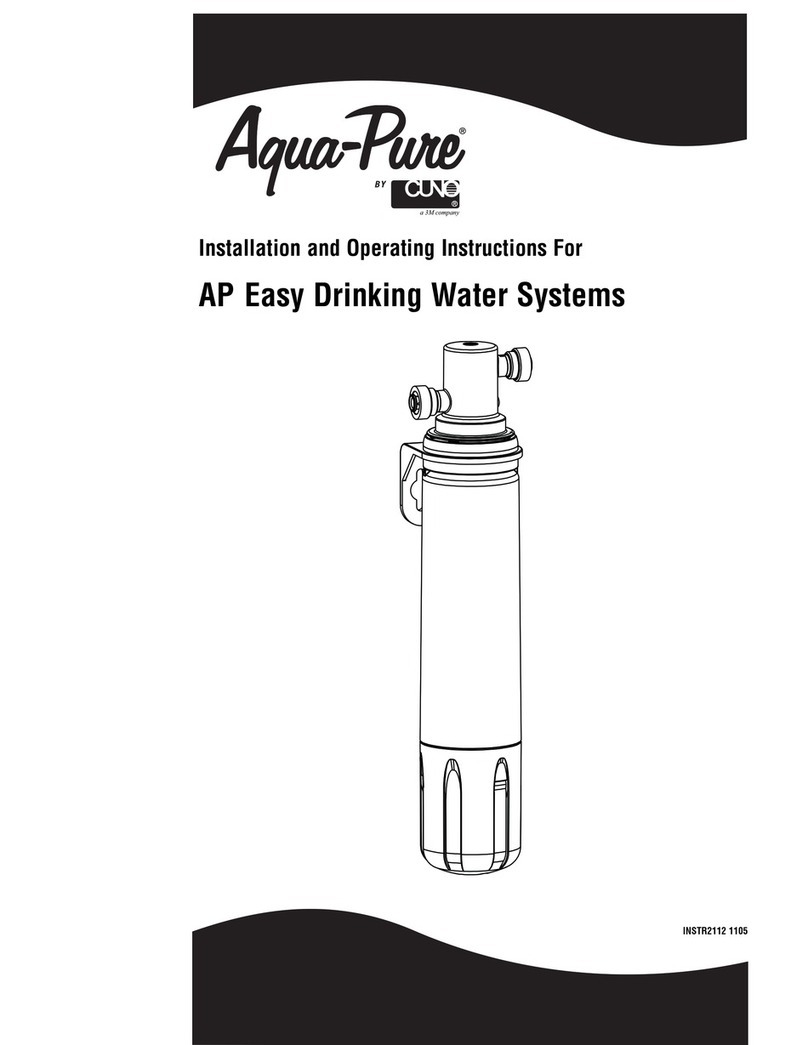
Cuno
Cuno AP Installation and operating instructions
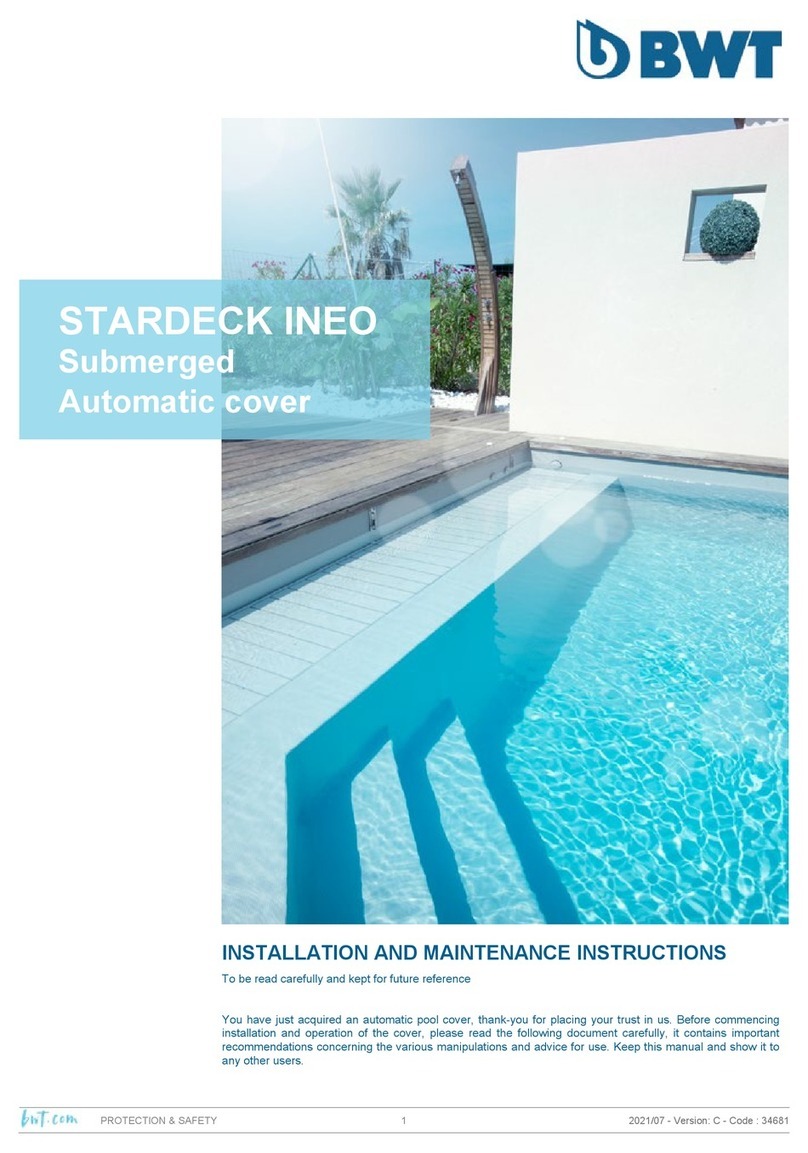
BWT
BWT STARDECK INEO Installation and maintenance instructions

Riello
Riello 7200 Kombi Plus Installation, operation and maintenance manual
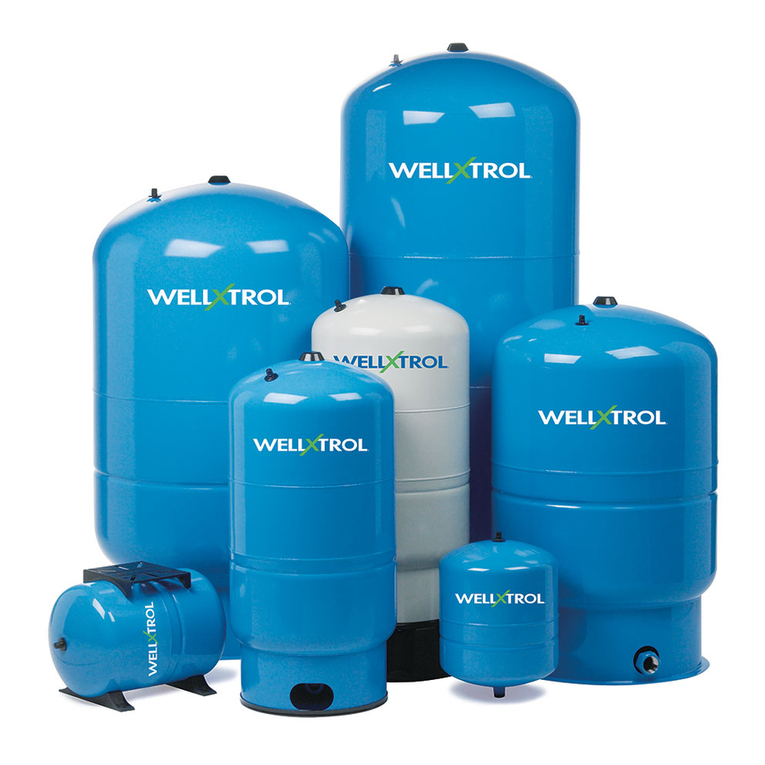
Amtrol
Amtrol WELL-X-TROL WX-101 Brochure & specs
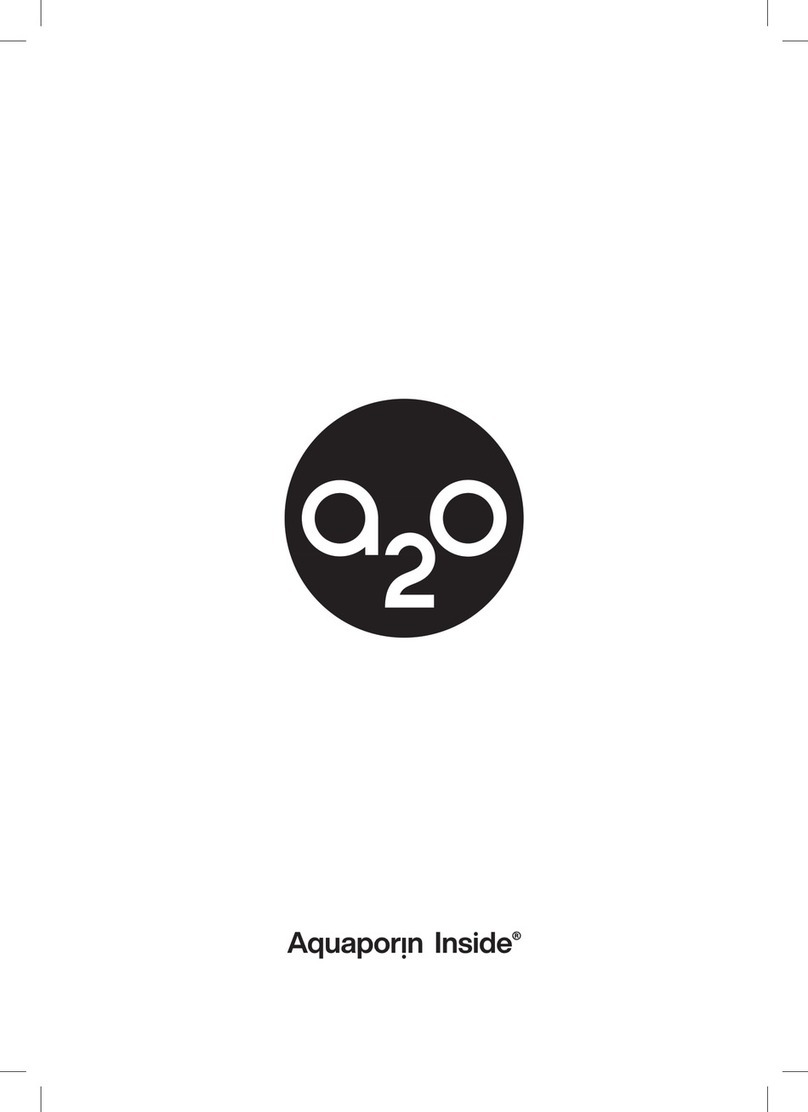
Aquaporin
Aquaporin A2O Pure manual
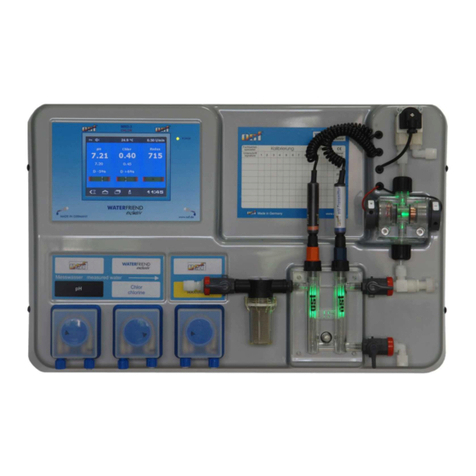
OSF
OSF WATERFRIEND MRD-3 Installation and operating instructions

Rainfresh
Rainfresh QS2 user manual

Everpure
Everpure Insurice Triple PF-i40002 Specification sheet

